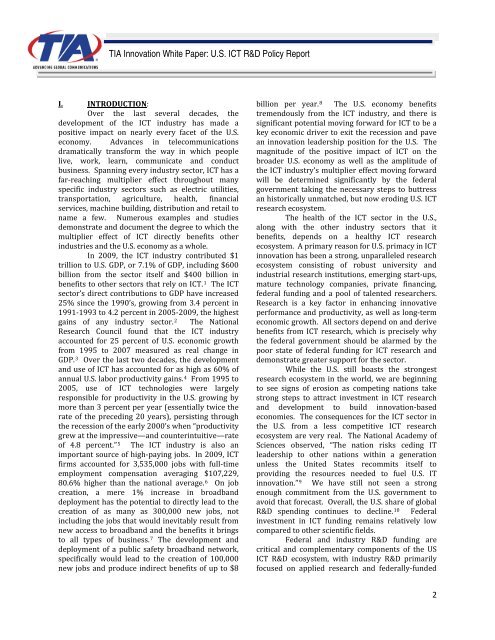U.S. ICT R&D Policy Report: The United States: ICT Leader or Laggard?
U.S. ICT R&D Policy Report: The United States: ICT Leader or Laggard?
U.S. ICT R&D Policy Report: The United States: ICT Leader or Laggard?
You also want an ePaper? Increase the reach of your titles
YUMPU automatically turns print PDFs into web optimized ePapers that Google loves.
TIA Innovation White Paper: U.S. <strong>ICT</strong> R&D <strong>Policy</strong> <strong>Rep<strong>or</strong>t</strong><br />
I. INTRODUCTION:<br />
Over the last several decades, the<br />
development of the <strong>ICT</strong> industry has made a<br />
positive impact on nearly every facet of the U.S.<br />
economy. Advances in telecommunications<br />
dramatically transf<strong>or</strong>m the way in which people<br />
live, w<strong>or</strong>k, learn, communicate and conduct<br />
business. Spanning every industry sect<strong>or</strong>, <strong>ICT</strong> has a<br />
far-reaching multiplier effect throughout many<br />
specific industry sect<strong>or</strong>s such as electric utilities,<br />
transp<strong>or</strong>tation, agriculture, health, financial<br />
services, machine building, distribution and retail to<br />
name a few. Numerous examples and studies<br />
demonstrate and document the degree to which the<br />
multiplier effect of <strong>ICT</strong> directly benefits other<br />
industries and the U.S. economy as a whole.<br />
In 2009, the <strong>ICT</strong> industry contributed $1<br />
trillion to U.S. GDP, <strong>or</strong> 7.1% of GDP, including $600<br />
billion from the sect<strong>or</strong> itself and $400 billion in<br />
benefits to other sect<strong>or</strong>s that rely on <strong>ICT</strong>. 1 <strong>The</strong> <strong>ICT</strong><br />
sect<strong>or</strong>’s direct contributions to GDP have increased<br />
25% since the 1990’s, growing from 3.4 percent in<br />
1991-1993 to 4.2 percent in 2005-2009, the highest<br />
gains of any industry sect<strong>or</strong>. 2 <strong>The</strong> National<br />
Research Council found that the <strong>ICT</strong> industry<br />
accounted f<strong>or</strong> 25 percent of U.S. economic growth<br />
from 1995 to 2007 measured as real change in<br />
GDP. 3 Over the last two decades, the development<br />
and use of <strong>ICT</strong> has accounted f<strong>or</strong> as high as 60% of<br />
annual U.S. lab<strong>or</strong> productivity gains. 4 From 1995 to<br />
2005, use of <strong>ICT</strong> technologies were largely<br />
responsible f<strong>or</strong> productivity in the U.S. growing by<br />
m<strong>or</strong>e than 3 percent per year (essentially twice the<br />
rate of the preceding 20 years), persisting through<br />
the recession of the early 2000’s when “productivity<br />
grew at the impressive—and counterintuitive—rate<br />
of 4.8 percent.” 5 <strong>The</strong> <strong>ICT</strong> industry is also an<br />
imp<strong>or</strong>tant source of high-paying jobs. In 2009, <strong>ICT</strong><br />
firms accounted f<strong>or</strong> 3,535,000 jobs with full-time<br />
employment compensation averaging $107,229,<br />
80.6% higher than the national average. 6 On job<br />
creation, a mere 1% increase in broadband<br />
deployment has the potential to directly lead to the<br />
creation of as many as 300,000 new jobs, not<br />
including the jobs that would inevitably result from<br />
new access to broadband and the benefits it brings<br />
to all types of business. 7 <strong>The</strong> development and<br />
deployment of a public safety broadband netw<strong>or</strong>k,<br />
specifically would lead to the creation of 100,000<br />
new jobs and produce indirect benefits of up to $8<br />
billion per year. 8 <strong>The</strong> U.S. economy benefits<br />
tremendously from the <strong>ICT</strong> industry, and there is<br />
significant potential moving f<strong>or</strong>ward f<strong>or</strong> <strong>ICT</strong> to be a<br />
key economic driver to exit the recession and pave<br />
an innovation leadership position f<strong>or</strong> the U.S. <strong>The</strong><br />
magnitude of the positive impact of <strong>ICT</strong> on the<br />
broader U.S. economy as well as the amplitude of<br />
the <strong>ICT</strong> industry’s multiplier effect moving f<strong>or</strong>ward<br />
will be determined significantly by the federal<br />
government taking the necessary steps to buttress<br />
an hist<strong>or</strong>ically unmatched, but now eroding U.S. <strong>ICT</strong><br />
research ecosystem.<br />
<strong>The</strong> health of the <strong>ICT</strong> sect<strong>or</strong> in the U.S.,<br />
along with the other industry sect<strong>or</strong>s that it<br />
benefits, depends on a healthy <strong>ICT</strong> research<br />
ecosystem. A primary reason f<strong>or</strong> U.S. primacy in <strong>ICT</strong><br />
innovation has been a strong, unparalleled research<br />
ecosystem consisting of robust university and<br />
industrial research institutions, emerging start-ups,<br />
mature technology companies, private financing,<br />
federal funding and a pool of talented researchers.<br />
Research is a key fact<strong>or</strong> in enhancing innovative<br />
perf<strong>or</strong>mance and productivity, as well as long-term<br />
economic growth. All sect<strong>or</strong>s depend on and derive<br />
benefits from <strong>ICT</strong> research, which is precisely why<br />
the federal government should be alarmed by the<br />
po<strong>or</strong> state of federal funding f<strong>or</strong> <strong>ICT</strong> research and<br />
demonstrate greater supp<strong>or</strong>t f<strong>or</strong> the sect<strong>or</strong>.<br />
While the U.S. still boasts the strongest<br />
research ecosystem in the w<strong>or</strong>ld, we are beginning<br />
to see signs of erosion as competing nations take<br />
strong steps to attract investment in <strong>ICT</strong> research<br />
and development to build innovation-based<br />
economies. <strong>The</strong> consequences f<strong>or</strong> the <strong>ICT</strong> sect<strong>or</strong> in<br />
the U.S. from a less competitive <strong>ICT</strong> research<br />
ecosystem are very real. <strong>The</strong> National Academy of<br />
Sciences observed, “<strong>The</strong> nation risks ceding IT<br />
leadership to other nations within a generation<br />
unless the <strong>United</strong> <strong>States</strong> recommits itself to<br />
providing the resources needed to fuel U.S. IT<br />
innovation.” 9 We have still not seen a strong<br />
enough commitment from the U.S. government to<br />
avoid that f<strong>or</strong>ecast. Overall, the U.S. share of global<br />
R&D spending continues to decline. 10 Federal<br />
investment in <strong>ICT</strong> funding remains relatively low<br />
compared to other scientific fields.<br />
Federal and industry R&D funding are<br />
critical and complementary components of the US<br />
<strong>ICT</strong> R&D ecosystem, with industry R&D primarily<br />
focused on applied research and federally-funded<br />
2


